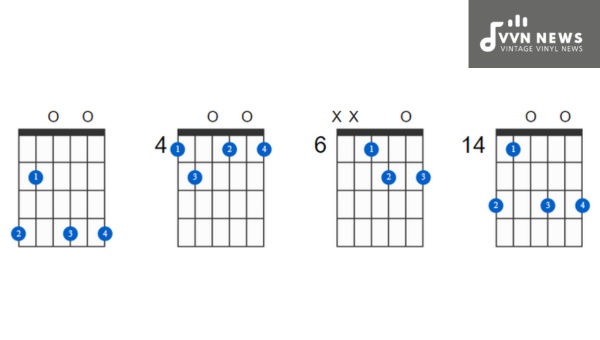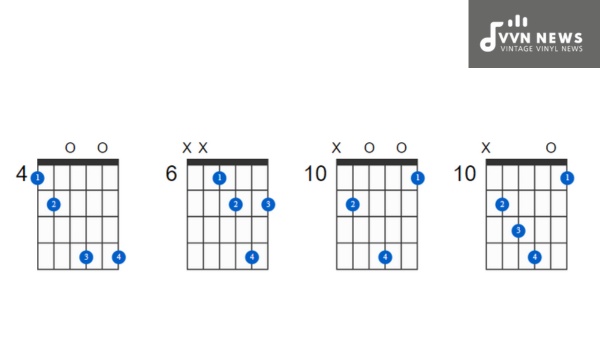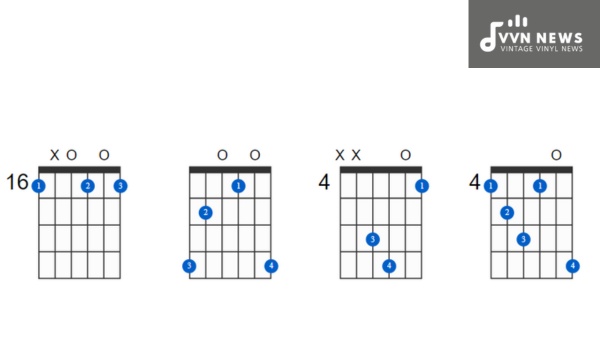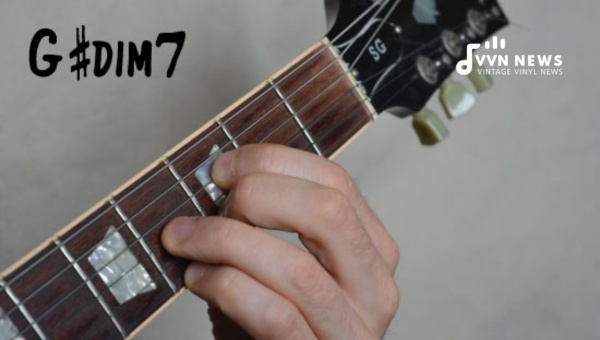In the vast landscape of music theory, there are specific terrains that require our full navigational skills.
One of these is the realm of diminished triads, more specifically, G Sharp diminished triad. In today’s discussion, we will be unfolding this very concept – a guide on G Sharp diminished triad.
A baseline of these intriguing musical structures can be a game-changer in your journey as an instrumentalist or a songwriter.
So cozy up with your instrument or pencil and paper because what lies ahead is bound to challenge your musical intellect and deepen your understanding of these complex yet captivating constructs.
Let’s journey together through this enriching guide on G Sharp diminished triad.
What is a G Sharp Diminished Triad?
A G Sharp Diminished Triad is a three-note chord consisting of the root note G#, the minor third interval B, and the diminished fifth interval D.
It is commonly used in jazz, classical, and contemporary music genres due to its unique and dissonant sound.
The diminished fifth interval creates tension and instability, making it an ideal choice for adding complexity to harmonies.
The structure of the G Sharp Diminished Triad is as follows:
- Root note: G#
- Minor third interval: B
- Diminished fifth interval: D
When played together, these three notes create a distinct and fascinating sound that can evoke a range of emotions. The dissonance of the diminished triad can add tension or unease to your compositions, which can be resolved by moving to a more stable chord.
The construction and characteristics of the G Sharp Diminished Triad will allow you to use it effectively in your music.
In the following sections, we will explore different inversions, popular songs featuring this chord, its role in chord progression and harmonic structure, as well as how to perform it on piano and guitar.
Also Read: A Flat Major Triad [Simplify Complex Music Theory Today]
G Sharp Diminished Triad Notes
The G Sharp Diminished Triad is composed of three notes: G#, B, and D. Let’s take a closer look at each note and its role within this chord.
- G# (Root Note): The G# is the foundation of the triad, serving as the starting point and establishing the tonal center. It provides a sense of stability and acts as a reference for the other notes.
- B (Minor Third Interval): The B is located two whole steps above the root note in the G Sharp Diminished Triad. It adds an element of tension but also contributes to the chord’s overall melancholic sound.
- D (Diminished Fifth Interval): The D is three and a half steps above the root note, forming the diminished fifth interval in this triad. It introduces dissonance and instability, creating a distinct musical character.
These three notes form the G Sharp Diminished Triad, creating a harmonically rich and intriguing sound due to their unique intervals and relationship to each other.
Inversions of G Sharp Diminished Triad
In music theory, inversions refer to different ways to arrange the notes of a chord. The G Sharp Diminished Triad can be rearranged in three inversions, each with the same three notes but in a different order.
These inversions provide alternate voicings and can add versatility to your compositions. Let’s take a closer look at the inversions of the G Sharp Diminished Triad:
- Root Position
In the root position inversion, the root note G# is placed at the bottom and acts as the foundation for the chord. The notes are arranged in ascending order: G#, B, D. This inversion provides a strong and stable foundation for harmonic progressions. - First Inversion
The first inversion of the G Sharp Diminished Triad is formed by moving the root note G# up an octave. This places B as the lowest note in the chord, followed by D and then G#. The first inversion gives a more open and airy sound compared to the root position. - Second Inversion
The second inversion involves moving both the root note G# and B up an octave, resulting in D as the lowest note, followed by G# and then B. This inversion offers a unique timbre compared to the previous two inversions.
It’s important to experiment with these inversions to find what works best for your musical ideas or desired moods in your compositions.
Combining different inversions within a progression can create interesting harmonic movements.
Role of G Sharp Diminished Triad in Chord Progression and Harmonic Structure

The G Sharp Diminished Triad plays a significant role in chord progression and harmonic structure.
By Using this chord effectively can elevate your compositions and add depth to your music. Here’s a guide on how the G Sharp Diminished Triad can be utilized:
Tension and Resolution
The G Sharp Diminished Triad creates tension due to its dissonant nature. This tension can be resolved by moving to a more stable chord, such as a major or minor triad.
The dissonance of the diminished triad can create a sense of anticipation, leading the listener’s ear to expect resolution naturally.
Also Read: A Major Triad [Master This Building Block Of Music]
Passing Chords
The G Sharp Diminished Triad is often used as a passing chord between two stable chords. By inserting the diminished triad between two chords, you can add an interesting shift in tonality.
This technique creates movement and can enhance the overall flow of your music.
Modulation and Key Changes
The G Sharp Diminished Triad is also commonly used for modulation or key changes. By introducing this chord in different keys, you can smoothly transition from one key to another.
The diminished nature of this triad allows for seamless modulation while retaining a sense of tension and resolution.
Secondary Dominant Function
In functional harmony, the G Sharp Diminished Triad can function as a secondary dominant chord. When used as such, it creates temporary tension that resolves back to the tonic or another stable chord. This adds complexity to your compositions and broadens your harmonic palette.
Voice Leading Techniques
Voice leading is an essential aspect of harmony, focusing on smooth melodic movement from one chord to another.
The G Sharp Diminished Triad provides unique voice-leading opportunities due to its close relationship with dominant seventh chords.
By utilizing voice-leading techniques with this triad, you can create smooth transitions and interesting melodic lines.
Expanded Harmonies
The G Sharp Diminished Triad can also be used to expand harmonies. By adding additional notes to this triad, such as seventh or ninth intervals, you can create more complex and rich-sounding chords.
Experimenting with extended harmonies opens up new possibilities for your compositions and allows for greater harmonic diversity.
The G Sharp Diminished Triad is a versatile and captivating chord that has its place in chord progressions and harmonic structures.
Whether it’s creating tension and resolution, acting as a passing chord, modulating between keys, or expanding harmonies, knowledge of how to incorporate this triad effectively can greatly enhance your musical compositions.
Also Read: F Sharp Diminished Triad [Boost Your Musical Finesse Today]
How to Play a G Sharp Diminished Triad on Piano and Guitar

If you’re looking to incorporate the unique sound of the G Sharp Diminished Triad into your music, here are simple instructions on how to play it on both piano and guitar.
On Piano:
- Find the G# note on your piano keyboard. It should be located to the right of the group of two black keys, specifically on the black key.
- With your right hand, place your thumb (1st finger) on G#.
- Skip two white keys to find B. Place your middle finger (3rd finger) on B.
- Skip another two white keys to find D. Place your pinky finger (5th finger) on D.
- Play these three notes simultaneously to create a G# Diminished Triad chord.
Remember that a diminished triad consists of three notes stacked with minor third intervals.
On Guitar:
To play a G Sharp Diminished Triad on guitar, you’ll need to use barre chords.
- Position your index finger across all strings at the 4th fret (barre position).
- Place your ring finger in the 6th fret of the A string, which will be playing the root note, G#.
- Press down with your middle finger on the 5th fret of the D string, which will produce B, the minor third interval.
- Lastly, press down with your pinky finger at the 6th fret of the G string for D, completing the diminished fifth interval.
By strumming all six strings while keeping these positions intact, you can play a full voicing of a G Sharp Diminished Triad chord on guitar.
Also Read: B Flat Diminished Triad [Guide for Novice Musicians]
Songs featuring the G Sharp diminished triad

The G Sharp Diminished Triad can be found in various songs across different genres. Its dissonant and unique sound adds a touch of complexity to these compositions. Here are a few notable examples:
- “Eleanor Rigby” by The Beatles – In this iconic song, the G Sharp Diminished Triad is used to create tension and accentuate the melancholic atmosphere of the piece. It is prominently featured in the opening chords of the song.
- “Fly Me to the Moon” by Frank Sinatra – This beloved jazz standard incorporates the G Sharp Diminished Triad during the chord progression, adding a layer of sophistication and intrigue to its harmonic structure.
- “Somewhere Over the Rainbow” by Harold Arlen – The G Sharp Diminished Triad makes an appearance in this timeless classic from “The Wizard of Oz.” It can be heard towards the end of some musical phrases, enhancing the emotional impact of the song.
- “As Time Goes By” from Casablanca – This romantic ballad is known for its memorable melodies and lush harmonies. The G Sharp Diminished Triad appears strategically in certain sections, creating a sense of longing and nostalgia.
- “Nuages” by Django Reinhardt – In this beautiful jazz composition, Reinhardt employs the G Sharp Diminished Triad to add texture and interest to his guitar playing. The dissonance created by this chord choice complements his improvisations.
These songs represent just a small sample of how musicians have incorporated the G Sharp Diminished Triad into their compositions.
By studying these songs and analyzing their usage, you can gain insight into how to employ this chord effectively in your music.
FAQs about G Sharp Diminished Triad
How do I form a G Sharp Diminished Triad?
To form a G Sharp Diminished Triad, start with the root note G#, then add the minor third interval B, and finally, include the diminished fifth interval D.
Can the G Sharp Diminished Triad be played in different inversions?
Yes, the G Sharp Diminished Triad can be played in three different inversions: root position (G#-B-D), first inversion (B-D-G#), and second inversion (D-G#-B).
What is the role of the G Sharp Diminished Triad in chord progressions?
The G Sharp Diminished Triad often functions as a passing chord or a transitional chord, providing tension that leads to a more stable chord or resolving to another harmony.
Does the G Sharp Diminished Triad have any notable characteristics in music?
Yes, the diminished fifth interval in the G Sharp Diminished Triad creates dissonance and tension, adding complexity and depth to your compositions.
Are there any famous songs that feature the G Sharp Diminished Triad?
Yes, “Summertime” by George Gershwin uses the G Sharp Diminished Triad in its opening melody, showcasing its ability to convey emotion and create impact within a song.
Conclusion
The G Sharp Diminished Triad is a versatile and unique chord that can add depth and complexity to your compositions.
With its construction and characteristics, you can effectively incorporate it into your music, whether you’re a beginner or an experienced musician.
Experimenting with different inversions, exploring their role in chord progressions, and learning how to perform them on piano and guitar will expand your musical palette and enhance your compositions.
So embrace the dissonant sound of the G Sharp Diminished Triad and unlock new harmonic possibilities in your music.








